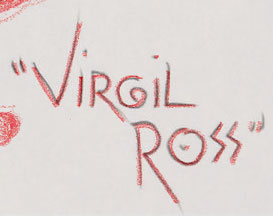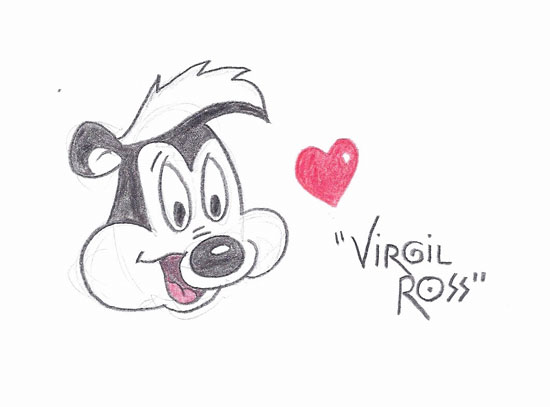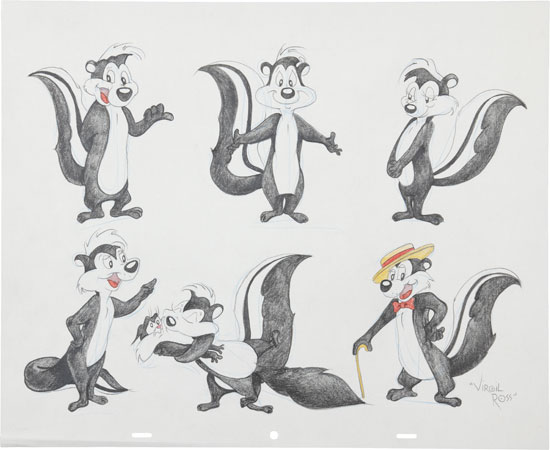(Most images in this post can be clicked for larger versions.)
So what are my Warner Bros. animation bona fides? Simply put: I'm a cartoon geek. You all know that already. More than that, however, I worked on the animated film festival circuit for years, met countless animators, and in the early 90s I co-produced and co-curated a Bugs Bunny film festival which toured the nation. During this tour, when the festival played in Orange County, California, and Los Angeles, I was honored to meet and dine with Chuck Jones and his daughter/manager Linda Jones, and got to visit their gallery in Corona del Mar. Imagine what a treat it was to hear Mr. Jones tell stories of the Termite Terrace days, his long-term memory crystal clear. At dinner, he also honored me by drawing a perfect Daffy Duck in my journal. The drawing (since lost; I don't want to talk about it) was fast, loose, expressive... alive.
I see none of that in the "Virgil Ross" drawings sold by the Gallery on Baum, shown above. These are rote, leaden, laborious, clumsy. Furthermore, they all appear to be traced, and Ross hardly needed to trace to draw the characters he had helped develop and then animate via tens of thousands of drawings made over several decades. Let's take a look at a case study. Here's another "Virgil Ross" fake, this one a much better effort by whoever drew it, sold just days ago by the Gallery on Baum:
I've already discussed some of the hallmarks of tracings in this series, but the most telling indicator that this drawing is a tracing is that every single line in it has a blunt end; in other words, none of the lines are fast, and therefore do not have the thin, trailing edges which indicate quick pencil work. The next step was to see if I could find the source from which this was traced, and that was easy enough. Here is a model-sheet-style drawing of Pepe le Pew by Virgil Ross, sold for $262.90 in 2010 by Heritage Auctions, and currently available on eBay for an inflated $899 from Comic-Mint:
(Again, you can click all these images for larger versions.)
Note that the Heritage/Comic-Mint drawing is full of those thin, trailing edges from the fast pencil lines, most tellingly on Pepe's face and, damningly, the letters of the signature. (The Marvin the Martian drawing above also comes from one of these Heritage/Comic-Mint drawings.)
The signature was done on a slightly different scale, but also matches up suspiciously well:

Now here's where things get complicated, and we confront some ugly truths about the "Animation Collectibles" industry. That "genuine" Virgil Ross Pepe le Pew model sheet is kind of a fake, too. It's not a real, production model sheet made in the 40s as a guide for animators, but a facsimile of one made especially for the burgeoning animation art market in the 1980s and 90s. The current owner of the drawing, Comic-Mint, dates it to the early 90s, and that seems about right to me. Did Virgil Ross really draw it? Yeah, why not. But he was ollllld by this time, and that accounts for the fact that these drawings, too, aren't all that great. Ross apparently made a whole series of these ersatz "model sheets" around this time (see a bunch of them in the archives at Heritage), although I don't know who for; I'm assuming for a specialty animation art gallery who offered him a good deal. Ross signed up for a lot of this shit.*
So why was Virgil Ross making these kinda fakey things, basically forgeries of his own work? Ha, well, for a buck. Why not? Plus, there was demand for it, because animation art became really "hot" in the 80s and 90s. Too hot. There was a huge demand, but not enough genuine, surviving production art to fill it. The survival rate for authentic production art from Warner Bros. cartoons was particularly poor: the studio had routinely scrubbed cels clean for re-use, and seemed to love nothing more than to shovel archived drawings and artwork into furnaces. This lack of product created a vacuum into which various kinds of forgers and fakers were sucked, and in many cases the fakers were old-timers like Virgil Ross, who were only too happy to draw Bugs Bunny again for a decent paycheck.
And that's why the animation art industry more or less crashed in the late 90s, because so many galleries pumped out so much fake and semi-fake junk, from the ersatz model sheets drawn by real animators like Virgil Ross, to the whole "limited edition cel" scam, wherein mass-produced serigraphs (glorified silkscreens, basically) which looked like real production cels were sold to collectors who didn't really understand the difference. My dentist has this crap on the walls of his office, doesn't yours? These things clog the market today, and their values have plummeted to well under what they sold for when brand new. Genuine production artwork prices have gone down, too, but not nearly as much, because good production art is rare.
So here's the unfortunate fact about collecting genuine Warner Bros. animation art which has been true since the 1980s: unless you are rich, you are not going to get anything good. That is a fact.
But let's get back to the Gallery on Baum, seller of many bad, fake Virgil Ross drawings (and many bad, fake Friz Freleng drawings). Not only are these things forgeries, drawn by whom I do not know, and not only are they tracings, but they are tracings from things that are kind of fake to begin with!
And that's yet another reason why if you don't know what you're doing, and if you aren't really obsessive and observant, or willing to put in the time to read about a million books, collecting cartoon art probably isn't for you, and you'll get burned, just like all those people who have purchased fake drawings from the Gallery on Baum.
To be continued!
*From ASIFA's bio of Virgil Ross:
As his career wound down, he returned to projects involving the old Warner Bros. characters. He also spent some of his time doing work for galleries and attending opening of Warner Bros. stores which featured his artwork.
Heck, he deserved it.






9 comments:
"(since lost; I don't want to talk about it.)" may be the most dreadfully mysterious phrase I've seen in ages. Thanks for the quick, thorough summary of the cartoon art market over the last 30 years.
The comic strip cartoon market isn't as plagued with trash as the animation art market. Survival rates for original comic strip and comic book art are way, way higher, and since they're published pieces, they're significantly harder to fake.
That's the point I want to drive home over and over and over: stick with published art and original, period production art. And that applies to those fakey Virgil Ross "model sheets" as well. After all, that "genuine" Virgil Ross drawing sold on Heritage for a pittance, less than $300, and that's because Heritage bidders are savvy and knowledgeable and tend to know fakey stuff when they see it.
It is absolutely true that Warner Bros. washed and reused their cels, as painful as that is to contemplate. One, they had no idea that their work would someday be thought valuable. Two, many really classic cartoons were made during the war, and materials had to be patriotically conserved and recycled. But what we wouldn't give for a production cel of the little gremlin from "Falling Hare."
Right, and Warner Bros. was probably the most gung-ho about re-using stuff and destroying "useless" leftover archival files. More Fleischer Bros. stuff even, survived than WB. The very little surviving stuff from Warner from the 30s and 40s, their "classic" period, is super scarce.
I know what you mean about being able to tell at a glance. That happened to me when I saw the Dan Rather/Bush documents in 2004. They were so obviously produced with Microsoft Word that the only thing that shocked me was that nearly nobody else in America could see the glaring, blatant truth. My brother's selectric.org site was bombarded by people who had no idea that Selectrics didn't have proportional spacing.
Is selling forged artwork illegal?
Fascinating series, PSP. A friend works in legit lithograph printing. He's also got a lot to say about that market.
I guess the Flintstones cel my mom has is a fake, but don't think my sister paid alot for it. Our family enjoys it because it shows Flinstones family band and we played folk music for ourselves & friends' parties. Several siblings became semi-professional & the grandkids are in school bands.
Point: Best for most of us to just buy art we enjoy and can afford. The collectibles as investment market is pretty gross, isn't it?
Well, sure, when it comes to that made-for-market stuff, if you like the picture, go for it!
Dude, this is some of your best bloggeing. Fascinating stuff.
Post a Comment